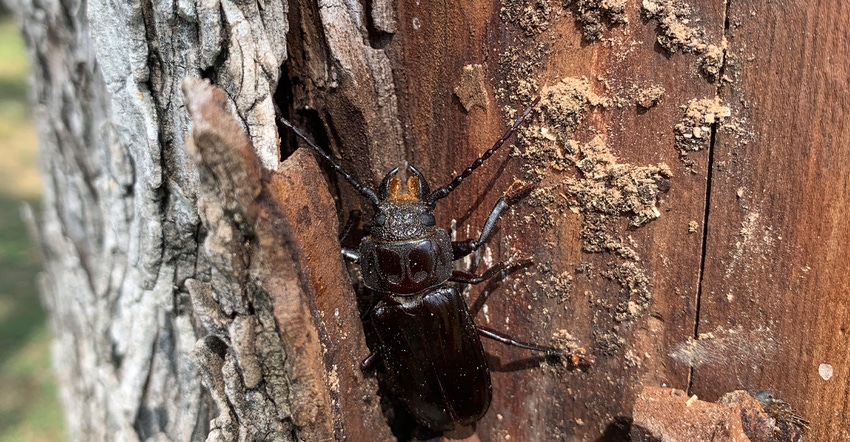October 10, 2022

A summer without significant rain is likely to yield an autumn without vibrant fall colors.
Trees across Texas are stressed from the impending drought. Despite late summer rain, much of Texas remains abnormally dry or in some stage of drought and the fall forecast is warmer and drier than average, all factors dulling fall's foliage.
“Many trees put on fewer, smaller leaves this spring or started to change color or prematurely drop their leaves in the summer,” said Karl Flocke, Texas A&M Forest Service woodland ecologist. “All of this will most likely lead to fall colors that are less impressive than in years past.”
Deciduous trees drop their leaves in the fall to conserve energy. Normally, fall colors start showing when the leaves' green chlorophyll begins breaking down.
“However, due to the drought, some trees have already defoliated,” said Courtney Blevins, Texas A&M Forest Service urban forester. “Others still have their leaves, but they are dead and brown. These trees obviously will not be giving us any fall colors to enjoy this year.”
The best opportunity to see fall foliage at its peak in Texas will be mid- to late-November, according to a fall foliage predication map at smokymountains.com.
 Bald cypress trees near Leakey, Texas. (Photo by Texas A&M Forest Service)
Bald cypress trees near Leakey, Texas. (Photo by Texas A&M Forest Service)
During prolonged periods of drought, trees can generate yellow and brown pigments to protect their photosynthetic organs from damage caused by excess sunlight.
“This is similar to the process that causes the color change of leaves in the fall, but instead of being triggered by cold weather, it is caused by abnormally dry conditions,” Flocke said. “This is one of the reasons why people may have noticed dull yellows and browns across Texas for months now, even though we have still not experienced widespread cold weather.”
Even when drought conditions relent, trees could struggle for years with the effects of the prolonged dry period. Those effects include secondary pests and diseases that target already stressed trees.
“There are many long-term effects that trees will have to deal with years after the drought has ended,” said Blevins. “They don’t just suffer during the drought. Add to this the stress from the 2021 freeze, and it complicates the situation even further.”
The Texas A&M Forest Service cites the following insects as potential threats to drought-stressed trees.
Wood-boring insects, root rots and canker-causing pathogens are particularly common in many tree species following drought. Trees also may be stressed by human activities, such as construction or other actions that disturb or compact soil or damage roots.
There are dozens of species of wood-boring insects but they are all similar in destruction, and infestations can increase dramatically in stressed trees. Wood borers, particularly bark beetles, flatheaded borers and longhorn beetle larvae, tunnel under the bark, and if enough of them colonize a tree, it will eventually die from damage to the phloem layer – the part of the tree that transports food.
In pine trees, infestations of Ips bark beetles, also known as "engraver beetles," can prove especially devastating after drought. The beetles will feed on the tissue of the trees, causing the pine needles to fade to a light rust color before turning dark brown and eventually falling off and defoliating the trees. By the time a pine tree starts turning colors, it could be too late to save.
In live oaks and other hardwoods, ambrosia beetles are common after drought or stress periods, with compacted toothpick-shaped sawdust coming out of the bark as a typical sign of infestation. Symptoms of an infestation include the sudden discoloration of leaves in the crown or branches. Infestations in juvenile trees usually prove fatal. Mature trees may survive the infestation but typically makes the tree susceptible to other health issues.
Flocke recommends the following steps to assess and care for damaged trees.
The best option is to ward off an attack by keeping trees healthy so that they won’t be attractive to beetles and their natural defenses can fend off attacks.
With many shade trees going into premature dormancy and drought stressed, it can be difficult to assess their health. Just because leaves begin to fall from a tree, does not mean the tree is dead. For small trees, you can use a fingernail to scrape some of the smaller twigs. If there is green underneath, the tree is not dead.
Providing water is the most helpful way to reduce the stress to trees during drought conditions. Established trees may not need supplemental water, but should be monitored for signs of stress, including leaves that are dropping or wilting, small or malformed leaves, and yellowing or browning of the tips of leaves.
Younger trees should be watered up to three times per week in the absence of precipitation. Early in the morning and late in the evening are the best times to water to avoid the water being lost to evaporation during the heat of the day.
The toll from the drought on the state’s trees won’t be known for some time, Flocke says, as it could take months for stressed trees to show symptoms. In the meantime, landowners should keep a close watch on their trees and take measures to maintain tree health throughout the year.
Source: is AgriLife TODAY, which is solely responsible for the information provided and is wholly owned by the source. Informa Business Media and all its subsidiaries are not responsible for any of the content contained in this information asset.
Read more about:
DroughtYou May Also Like




